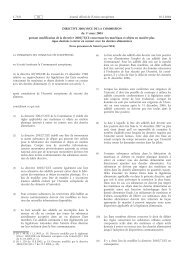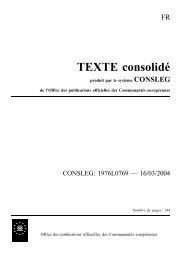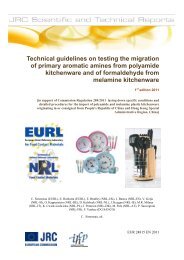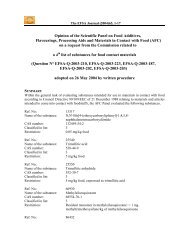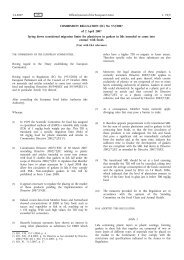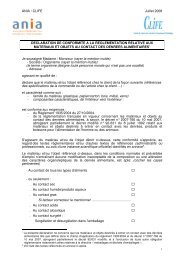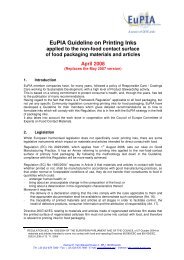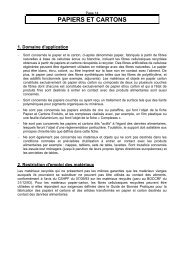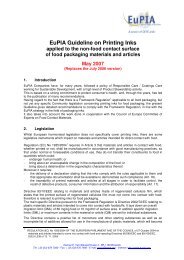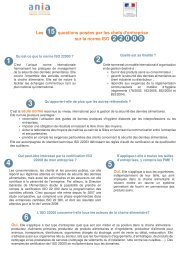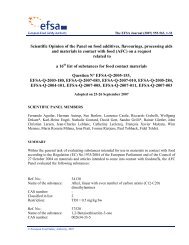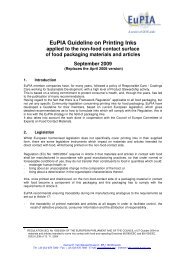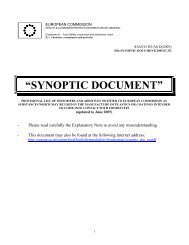WORKING DOCUMENT - Contact alimentaire
WORKING DOCUMENT - Contact alimentaire
WORKING DOCUMENT - Contact alimentaire
- No tags were found...
Create successful ePaper yourself
Turn your PDF publications into a flip-book with our unique Google optimized e-Paper software.
ANNEX IXGLOSSARY1. "Additives" are substances which are incorporated into coatings for direct foodcontact to achieve a technical effect in the finished material or article. They areintended to be present in the finished materials or articles;2. “Aids to Polymerisation” are substances, which directly enable the formation ofthe polymers or resins, used as components of coatings. They include initiators,polymerisation catalysts, chain transfer agents. They are usually reactivesubstances which are bound to the polymer. They are outside the definition ofadditives, but are currently covered in Council of Europe Resolution AP(92)2.3. “Authorised substances” are substances in a community or national list, includingthe German recommendations.4. "Authority" means European Food Safety Authority, as set by Regulation (EC) No178/2002;5. “Coated light metal packaging” comprises cans, ends, closures , aerosols andtubes for food and beverage, which have an organic coating applied to all or partof the food contact surface and pails (with a maximum volume of 40L).6. "Coating" means a product mainly prepared from one or more mainly organicsubstances (raw materials), which in its finished state does not form a selfsupportinglayer or film, but when it is applied onto a substrate and forms a partialor an integral layer, which has certain intended technological effects in thematerial or article. Organic coatings are typically applied in a liquid (solution ordispersion) or powder state and need to dry, cure or solidify to reach their finishedstate. Inorganic coatings largely based on inorganic materials including metalsand oxides are excluded from this definition.7. “Coatings” may be formulated from resins/ polymers / prepolymers, crosslinkingagents, as well as additives, such as waxes, defoamers, wetting aids, flow aids,organic solvents, pigments, etc. (See Annex IV).8. “Crosslinking” is the process by which functional groups present in the thermosetpolymers or pre-polymers react with those present in a crosslinking agent orprepolymer or themselves to form a crosslinked structure of increased molecularweight to form the final coating in contact with the foodstuff. Crosslinking isgenerally achieved by thermal treatment in high temperature ovens. It can also beobtained at ambient temperature by mixing reactive two pack systems.9. “Curing” of coatings on light metal packaging is normally the high temperatureprocess by which the applied coating layer to the metal is converted into the finalcoating (layer) (through crosslinking,) which is in contact with the foodstuff. In thecase of heavy duty coatings, curing is typically achieved at ambient temperatures,using a two component system, mixed prior to application.54Europäische Vereinigung der Lack-, Druckfarben- und KünstlerfarbenindustrieEuropean Council of Paint, Printing Inks and Artists' Colours IndustryAvenue E. Van Nieuwenhuyse 4 - BE-1160 BrusselsTel:+32 (0)2 676 7480 - Fax: + 32 (0)2 676 7490 - E-mail: secretariat@cepe.org -Internet: http://www.cepe.org/




